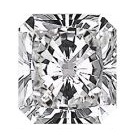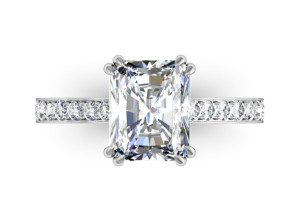Radiant Shape
 The Radiant cut has more facets than most cuts (62 or 70) and has distinctive trimmed corners. It is a hybrid of the brilliant and stepped cuts and, therefore, has a wonderful balance of depth and sparkle.
The Radiant cut has more facets than most cuts (62 or 70) and has distinctive trimmed corners. It is a hybrid of the brilliant and stepped cuts and, therefore, has a wonderful balance of depth and sparkle.
Unlike the square Princess cut, the cropped corners of a Radiant cut minimise the potential of chipping in this thin and delicate part of the stone. Another bonus of the Radiant cut is that a well-cut radiant can appear to have a better diamond color than a stone with a simpler cut and it’s extra facets can help conceal diamond flaws and inclusions for overall better clarity. This cut maximises the diamond carats by using more of the gem in visible ways, rather than obscuring useless weight beneath the surface of the stone. All of these distinctive characteristics make the Radiant cut the most firey of all the square and rectangular stones, making it a perfect choice for someone loves sparkle!
When considering the setting style for this cut of diamond, avoid the bezel style if possible as the surronding metal can dampen it’s light reflection and therefore it’s fire. Claw settings work well – I particularly like the look of double claw settings on Radiant cut stones like this example below:
Facet Pattern
The Radiant cut is the first cut to have a brilliant-facet pattern applied to both the crown and pavilion of the stone. It is a hybrid of both the Brilliant and step-cut facets and therefore has equal brilliance to other triangular faceted diamonds such as the oval and pear shapes.
Square stones such as the Radiant cut tend to have quite deep pavilions and this contributes to the increased depth in these stones. This is a necessary feature of square stones to bring out the maximum brilliance possible. The best (and most valuable) Radiant cuts will have a “table” or flat top surface that takes up more than 61% of the diamond’s visible width.
History
The first Radiant cut was designed by Henry Grossbard of the Radiant Cut Diamond Company (RCDC) in 1977. Prior to this all diamonds with square or step-cut edges appeared less firey than they do today. Radiant cuts as we know and love them today, were launched by the RCDC in 2002.

